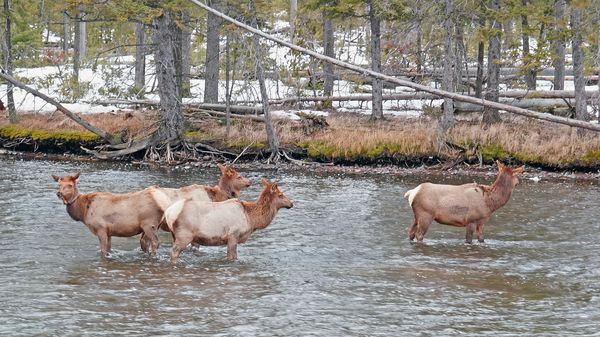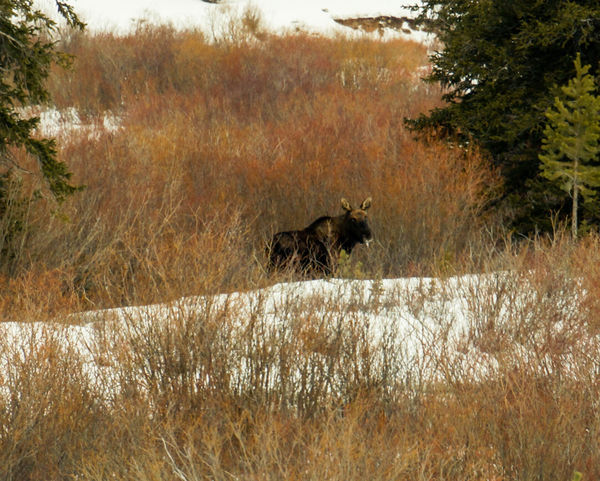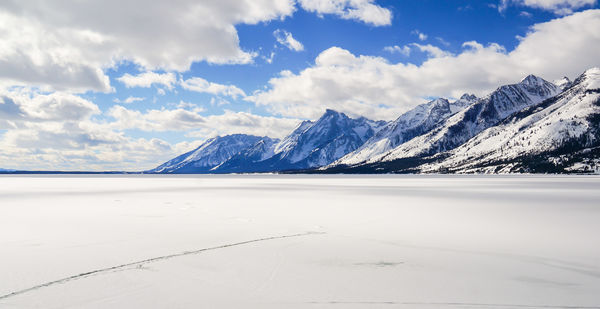Prime lenses for Yellowstone?
Oct 25, 2017 09:53:58 #
Oct 25, 2017 10:02:29 #
tomad
Loc: North Carolina
I went with 28, 50 and 300 primes with a 2x teleconverter and a 75 to 200 zoom. Pretty much covered everything but sometimes I wished for even more reach. That was with 35mm film camera bodies. Looking forward to going back with a big zoom bridge camera.
Oct 25, 2017 10:06:02 #
billnikon
Loc: Pennsylvania/Ohio/Florida/Maui/Oregon/Vermont
Nalu wrote:
Because they are switching to Canon?
Actually, we are selling Nikon kit lenses so we can buy better Nikon lenses.
Oct 25, 2017 10:08:39 #
wapiti wrote:
For prime lenses, I would take a 35 and a 400 to 500. I would definitely include a 70-200 zoom. A 24-70 would be very handy. I've been to YNP many times. Back before the wolves, one could easily get by with a 300. Those days are gone. There are a lot of wolves in YNP and Grand Teton, which have rendered elk photography pretty much null and void. You still might get lucky in some areas[Mommoth] and get by with something smaller like a 300, but I wouldn't count on it.
...we saw lots of Elk in YNP and Jackson Hole, lots of Coyotes, Foxes and Moose (Jackson Hole), the last two years, both summer & winter and then the 2000+ Elk that migrate to Jackson Hole every winter. Summertime, harder to see but still see them depending on their grazing area, High in Summer, Low in Winter. Agree that a 300m is the minimum he needs along with the 24-70....again all depends on the time of year. Cheers
Oct 25, 2017 10:18:01 #
billnikon wrote:
Good question. Why so many pro Nikon owners. There must be a really good answer to that question. Gee, I wonder. What could it be?
My theory: The average member is retirement age and started with Nikon when it was the game in town.

Oct 25, 2017 10:42:05 #
paulrph1
Loc: Washington, Utah
BobT wrote:
Is this even a practical idea? And if it is, what might you suggest as a 3 prime lens kit for such a trip; realizing that one wishes to capture most of what Y-Stone has to offer landscapes, to animals. Very interested in your comments on this. Thanks.
Sorry to tell you, but you will need the gamete. Too diverse and too many things to shoot. Take a Tripod. Shutter release. There may not be a more varied place on earth to photograph.
Oct 25, 2017 11:03:56 #
BobT, just a couple of photos from YNP & Grand Teton in the winter time a year ago....just to whet your appetite, its so beautiful and I plan to do another winter trip. We went out of West Yellowstone Mt.
The Elk were in a defensive posture in the river due to a pack of wolves in the area...and they were howling, gave the wife goose bumps, not to mention the cold air...we saw three, two blacks and a silver, feeding on an elk carcass they had killed two days earlier. A Moose moving away into the woods, \taken while driving, no chance to stop. Lake Jackson of a clear blue day, trail was an ice fisherman has already left
The Elk were in a defensive posture in the river due to a pack of wolves in the area...and they were howling, gave the wife goose bumps, not to mention the cold air...we saw three, two blacks and a silver, feeding on an elk carcass they had killed two days earlier. A Moose moving away into the woods, \taken while driving, no chance to stop. Lake Jackson of a clear blue day, trail was an ice fisherman has already left
Oct 25, 2017 12:24:04 #
I spent four summer seasons at YNP and agree with the recommendation for zoom vs prime lens, else you are going to find yourself spending more time changing lenses than grabbing shots. And, when it comes to animals, you don't want to be fumbling in your bag while the grizzly, wolf or bull elk strolls away into the woods.
Oct 25, 2017 12:41:26 #
amfoto1
Loc: San Jose, Calif. USA
BobT wrote:
Is this even a practical idea? And if it is, what might you suggest as a 3 prime lens kit for such a trip; realizing that one wishes to capture most of what Y-Stone has to offer landscapes, to animals. Very interested in your comments on this. Thanks.
Well, I gotta ask... WHY?
Zooms today are so good that there's no reason not to use some of them.
"Back in the day", when zooms really sucked, I didn't use many of them. Mostly just carried and shot with primes. That was "full frame" (film) and I traveled with: 20 or 21mm, 24mm, 35mm, 85 or 90mm (macro/portrait), 135mm and 300mm, plus a 1.4X or 1.5X to use with the 135mm and 300mm (combos that gave me roughly equivalent of 200mm and 450mm). Six primes plus a teleconverter.
Today I take advantage of zooms wherever possible. When I first switched to Canon gear I got: 17-35mm, 100mm macro, 300mm and 500mm, along with a 1.4X. It wasn't long before I added 70-200mm and then 24-70, along with several primes. But due to their size and weight I never carried both the 300mm and 500mm at the same time. That just wasn't practical. When I was traveling by car and shooting wildlife, I'd pack both, but only get out and use one or the other. When I traveling by air, I usually only took the 300mm.
With full frame, about the lightest kit I carry right now has 20mm, 24-70mm, 135mm and 300mm with 1.4X (used with both the 135 and 300). Sometimes when shooting only in good daylight I substitute a 28-135mm for the bigger 24-70 and 135mm lenses. Someplace like Yellowstone, I'd get and use 16-35/4 (for scenics), would want a macro such as a 90mm or 100mm, and a long prime lens such as 300/2.8 with 2X or 500mm w/1.4X. Or in good light conditions I'd instead use my 100-400mm, possibly with 1.4X.
With APS-C crop-sensor camera about the minimum I usually take is 10-22mm, 28mm and 60mm macro portrait (both small and fastt), and either 70-200mm and 300mm prime w/1.4X or 100-400mm zoom.
For me, just three lenses wouldn't be enough. I usually carry at least four.... And I see no reason to constrain myself unnecessarily by not using some modern, high quality zooms.
EDIT: I just saw that you're a Canon shooter, like me, and that you're using an APS-C camera... my recommended lenses:
Canon EF-S 10-18mm STM IS or EF-S 10-22mm USM... Scenic lenses. The 10-18mm is small, light and inexpensive (about $300 w/hood), a bit plasticky, uses 67mm filters... it's max aperture is f/4.5 at the wide end. The 10-22mm is a bit better "mid-grade" build quality, has a max aperture of f/3.5 at the wide end, and has USM focus, but does not have IS. It costs about $675 w/hood, uses 77mm filters. Both lenses have excellent image quality. Both are sold without hood, but make sure to get the correct one for either lens (Canon OEM hoods are a bit pricey, Vello clones are about half the price and probably work just as well). Make a point of getting a quality Circular Polarizer (such as B+W XS-Pro or F-Pro) for the wide/scenic lens, in particular.
Tamron SP 60mm f/2 Macro/Portrait ($525, hood incl.)... Up to 1:1 macro capable, internal focusing. Also has a stop larger aperture than most macro lenses, which makes it more "dual purpose" for portraiture. Not terribly fast focusing, but a versatile lens. An alternative is the Canon EF-S 60mm f/2.8 USM... which is a little faster focusing (still no speed demon), also is sharp, but a stop slower, and costs a bit less at $400 (plus $15 to $30 for a matched ET-67B hood). Both these have excellent image quality and are relatively compact to take on a trip. Personally I wouldn't want to be without a macro lens.... or at least a relatively close focusing non-macro and a set of macro extension tubes. I just see too many close-up/macro opportunities when out shooting... and it's nice when a macro lens can double as a portrait lens.
Personally I like to carry a Canon EF 28mm f/1.8 USM, too. On a crop-sensor camera, it serves as a "fast, slightly wide normal" lens and is quite compact, even with it's matched lens hood. Costs $509, plus $16 to $22 for EW-63II lens hood. The Sigma 30mm f/1.4 HSM is an even faster (2/3 stop) alternative, about the same cost, but it's A LOT bigger and heavier.
An alternative to much of the above... Canon EF-S 15-85mm IS USM. This is a very high quality, high performance, versatile very wide to moderate telephoto lens that might substitute for all the above lenses (if 15mm is wide enough... and if you don't need larger aperture lenses for low light/shallow depth of field... and if you have macro extension tubes to be able to boost it's 1:5 life size max magnification). Very high image quality, reasonable size and weight... Cost is rather high at $800 (plus $15 to $30 for separately sold EW-78E lens hood). But that price isn't so bad, if it replaces several other lenses.
And most certainly take your Canon EF 100-400mm.... plus at least a monopod to use it on (for longer shooting sessions). Sure, it's a relatively large and heavy lens, but you'll want it. It's a quite powerful telephoto on a crop-sensor camera. Can't use a teleconverter on it, though, with your camera (no autofocus and a very dim viewfinder to try to focus manually). Leave the 55-250mm at home (or in the car, if you're driving).
Stop worrying about swapping lenses! That's just silly. The cameras and lenses are designed and intended for lens changes. In fact, if you were to go with "primes only", you'd find yourself doing much more frequent changes than you will with zooms. Now, I do use at least two cameras much of the time, sometimes three, which minimizes my need to change lenses... but that's just to be able to switch very rapidly between them (not out of any concerns about dust or whatever). A lot of the time I'm shooting sports and need to transition between lenses very rapidly, but I sometime do similar when out shooting active wildlife.
Oct 25, 2017 13:10:29 #
BobT wrote:
Is this even a practical idea? And if it is, what might you suggest as a 3 prime lens kit for such a trip; realizing that one wishes to capture most of what Y-Stone has to offer landscapes, to animals. Very interested in your comments on this. Thanks.
Well, it is somewhat practical .......for the larger slower moving animals in Yellowstone I could very easily go with a older/cheaper manual focus lens in the area of 400mm f2.8, 3.5, 4, or 4.5 with 1.4X TC. or 500mm f4, 4.5 with TC or, If I were using Sony, skip the TC's and use the Clear Image Zoom and the 500 f8 af mirror lens. Birds or smaller animals in action will require AF - or very GOOD manual focusing !
For scenics, a 16mm on APSc or 24mm on FF and crop a bit if needed. For panos, a manual focus/manual diaphram 24mm for APSC and 35mm for FF in portrait orientation.
Oct 25, 2017 13:43:29 #
Jerry Coupe
Loc: Kent, WA
I used two zooms, a 24-70 and 700-200 plus my 300 (all f2.8 Canon L lenses) at Yellowstone in 2015. If only taking primes I would suggest at least a 24mm and then maybe a 135mm and a 300 or 400. For many of the geysers and hot pools 24 mm is just barely wide enough on a full frame body. For most of the animal shots, you will want a 300 or 400.
Have a great trip. Yellowstone is an awesome place to shoot.
Have a great trip. Yellowstone is an awesome place to shoot.
Oct 25, 2017 13:54:59 #
amfoto1
Loc: San Jose, Calif. USA
amfoto1 wrote:
...
And most certainly take your Canon EF 100-400mm.... plus at least a monopod to use it on (for longer shooting sessions). Sure, it's a relatively large and heavy lens, but you'll want it. It's a quite powerful telephoto on a crop-sensor camera. Can't use a teleconverter on it, though, with your camera (no autofocus and a very dim viewfinder to try to focus manually). Leave the 55-250mm at home (or in the car, if you're driving). ...
And most certainly take your Canon EF 100-400mm.... plus at least a monopod to use it on (for longer shooting sessions). Sure, it's a relatively large and heavy lens, but you'll want it. It's a quite powerful telephoto on a crop-sensor camera. Can't use a teleconverter on it, though, with your camera (no autofocus and a very dim viewfinder to try to focus manually). Leave the 55-250mm at home (or in the car, if you're driving). ...
EDIT and CORRECTION to the above...
... Most certainly get and take a Canon EF 100-400mm II IS USM.... Plus at least a monopod to use it on (for longer shooting sessions). Sure, it's a relatively large and heavy lens, and at about $2100 it ain't cheap... but you'll want it for wildlife. It's a quite powerful telephoto on a crop-sensor camera such as your T5i (equiv. to 160-640mm on full frame). Can't use a teleconverter on it, though, with your camera (no autofocus and a very dim viewfinder to try to focus manually). Leave the 55-250mm at home (or in the car, if you're driving). It's nowhere near long enough for a lot of wildlife photography. Alternatives such as Tamron or Sigma 150-600mm are bigger and heavier, not to mention harder to keep steady beyond 400mm. Both Sigma and Tamron are coming out with 100-400mm lens, too. The Sigma 100-400mm is available now and the Tamron 100-400mm will be arriving in stores soon, both selling for $800. The Sigma is smaller than the Canon 100-400mm, but close to the same weight. Image quality seems decent and early reviews are encouraging, however the Sigma doesn't have a tripod mounting ring or any provision to optionally add one, which alone would keep me from ever buying it. The Tamron appears to be about the same size/weight as the Canon, don't know about it's image quality yet though, there is minimal advance info about it (not even listed on Tamron's websites yet!).... It doesn't include, but there will be an optional, separately sold tripod mounting ring available for it.... at extra cost of course (I haven't seen a price for the t'pod ring... just for the lens alone).
However, among those lenses, something only the Canon 100-400mm lens has is fluorite. Canon uses an optical element made of that (along with other advanced types of glass) in most of their telephotos. Fluorite is an ideal material that greatly reduces chromatic aberration and gives telephotos a sharpness that can "make your eyes bleed" looking at the images. Problem is, fluorite is expensive.... rarely occurs naturally large enough for lens elements and is difficult to shape as needed. So Canon pioneered growing their own fluorite crystals, along with manufacturing techniques, and have been using it extensively in telephotos for four decades. Few other manufacturers use it at all now, though many have used it here and there in an occasional telephoto in the past. Just this year Nikon converted many of their modern telephotos to "FL" (but is asking much, much higher prices for them! Nikon's 70-200mm f/2.8 with FL costs almost 50% more than Canon's equivalent specification and equally good lens, which also uses fluorite)...
Oct 25, 2017 13:58:15 #
If you're driving take everything you own...if on a tour, minimize to the necessities
Oct 25, 2017 14:01:34 #
RRS
Loc: Not sure
BobT wrote:
Is this even a practical idea? And if it is, what might you suggest as a 3 prime lens kit for such a trip; realizing that one wishes to capture most of what Y-Stone has to offer landscapes, to animals. Very interested in your comments on this. Thanks.
We go several times a year and just got back. I shoot a 600mm f/4.0 on a full frame with a 1.4 available if needed and that's for the long shot with a tripod. I keep a 300mm f/2.8 with a 1.4 extender on a crop camera body for shooting from the car off a bean bag. That is it for primes however I also keep a 70-200mm f/2.8 on another crop body and either a 17-40 or a 24-70 on a full frame body. Three tripods, four bodies, five lenses and a spotting scope and after many years of shooting there I feel that it's better to be ready for almost anything. There is a lot to be said for a good zoom lens if you have to fly to Yellowstone but thank goodness we can drive!
Oct 25, 2017 14:11:36 #
BobT
Loc: southern Minnesota
I already own a Canon 100-400mm "L" MK1. Not about to spring for the newer one costing 2K+. THough it would be nice, I really can't rationalize the expense for the "II" version. I also have a Canon 10-18mm STM and Tamron 17-50mm f2.8. So based on what I'm reading here, those may be my 3 lens combo for Y-Stone. Perhaps I should seriously consider a 2nd body?
If you want to reply, then register here. Registration is free and your account is created instantly, so you can post right away.





